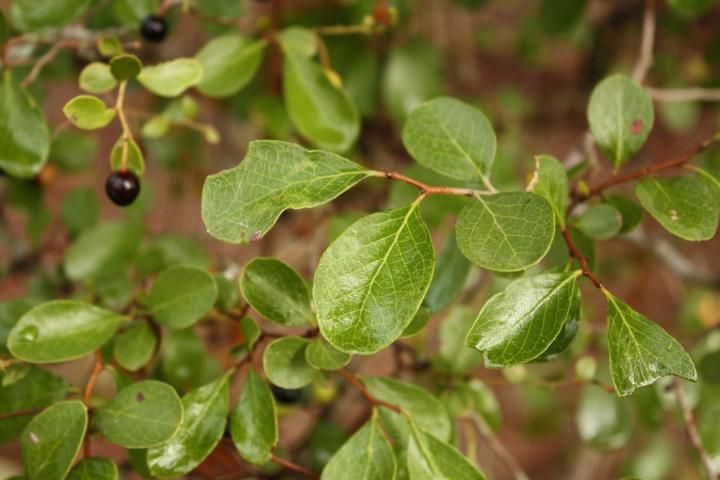Family
Ericaceae, heath family.
Genus
Vaccinium stems from the Latin word vaccin, or "of a cow."
Species
The species name, arboreum, stems from the Latin root "arbor," meaning "a tree," because it is the only North American member of the Vaccinium genus that reaches a size comparable to that of a tree.
Common Name
Sparkleberry, Farkleberry, Tree-Huckleberry, Winter-Huckleberry
The common name "sparkleberry" began to show up in the literature by 1891 and was given to the plant because of its rather shiny berries. The common name "farkleberry" is thought to be a misinterpretation of the word "sparkleberry."
Description
This native and small-statured tree grows best on sandy and dry soils, and can reach up to 25 feet in full sun to partial shade. Its range extends throughout the southeastern United States, from Virginia south to Florida, west to Texas, and north to Kansas. Leaves are deciduous but can exhibit more evergreen characteristics in the warmer climates of its southern range. The simple, alternately arranged leaves are 2 inches long and range in shape from elliptical to obovate. The tips of the leaves are rounded and the margins may or may not exhibit small serrations. The thinly veined leaves are a glossy dark green on the topside and a lighter green with slight pubescence on the underside. Bark is thin, flaky, and brownish red, and the trunk can grow as a single or multi-stemmed tree. Flowers are white and fragrant with 5 ¼-inch-long lobes that create a bell-shaped appearance. Flowers bloom during the spring months and emerge in clusters that measure 2 to 3 inches long. The shiny, black ¼-inch berries contain 8 to 10 seeds. Berries ripen in the fall and remain attached to the plant throughout the winter.

Credit: CA Floristics, CC BY-NC-SA 2.0
Allergen
This species causes few to no allergies.
Storm Tolerance
This small tree has a high resistance to wind.
Applications
Commercial/Practical
Sparkleberry has generally been grown for its showy flowers and eye-catching foliage rather than its edible yet bland berries. However, the larger fruits of sparkleberry have historically been used in jellies and pies.
Cultural
Settlers used the wood of sparkleberry as handles for tools, and it is thought that the Seminoles did as well.
Horticultural
This tree has great potential to be one of Florida's principle plants in landscape and horticulture, but is currently underutilized. Its small stature allows it to sit comfortably in both large and small yards, and its shiny foliage and numerous but small white flowers make this tree an enjoyable sight, particularly when it's in bloom. In addition, the delicate, bell-shaped flowers have a pleasant aroma, and the shiny black or blue berries further add to the aesthetic value of this tree. Even the trunk and limbs of sparkleberry are visually pleasing, with their twisting shapes and pale bark that flakes to reveal a pleasantly contrasting reddish color beneath.
Medicinal
Extracts of the leaves have been used to treat sore throats and loose stools, and juice from berries has also been used to treat recurring cases of dysentery.
Wildlife
Large and small mammals and numerous songbirds use the fruits produced by this tree as a food source in the fall.
References
Austin, D. F. 2004. Florida ethnobotany. Boca Raton, FL: CRC Press.
Borror, D. J. 1988. Dictionary of root words and combining forms. Mountain View, CA: Mayfield Publishing Company.
Duryea, M. and E. Kampf. 2007. Selecting Southeastern Coastal Plain tree species for wind resistance (FOR119). Gainesville, FL: UF-IFAS Florida Cooperative Extension Service. Retrieved from https://edis.ifas.ufl.edu/fr174
Godfrey, R. K. 1988. Trees, shrubs, and woody vines of Northern Florida and adjacent Georgia and Alabama. Athens, GA: The University of Georgia Press.
Haehle, R. J. and J. Brookwell. 2004. Native Florida plants: Low-maintenance landscaping and gardening. Lanham, MD: Taylor Trade Publishing.
Little, E. L. 2005. National Audubon Society field guide to trees, Eastern region. New York, NY: Alfred A. Knopf, Inc.
Nelson, G. 1994. The trees of Florida: A reference and field guide. Sarasota, FL: Pineapple Press.
Ogren, T. L. 2000. Allergy-free gardening: The revolutionary guide to healthy landscaping. Berkeley, CA: Ten Speed Press.
Osorio, R. 2001. A gardener's guide to Florida's native plants. Gainesville, FL: University Press of Florida.
USDA Natural Resources Conservation Service. (n.d.). PLANTS database. Retrieved from http://plants.usda.gov/index.html